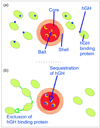Nanoparticle technology: amplifying the effective sensitivity of biomarker detection to create a urine test for hGH
- PMID: 20355230
- PMCID: PMC2869624
- DOI: 10.1002/dta.96
Nanoparticle technology: amplifying the effective sensitivity of biomarker detection to create a urine test for hGH
Abstract
Several clinical-grade immunoassays exist for the specific measurement of hGH or its isoforms in blood but there is an urgent need to apply these same reliable assays to the measurement of hGH in urine as a preferred 'non-invasive' biofluid. Unfortunately, conventional hGH immunoassays cannot attain the sensitivity required to detect the low concentrations of hGH in urine. The lowest limit of sensitivity for existing hGH immunoassays is >50 pg/mL, while the estimated concentration of urinary hGH is about 1 pg/m-50 times lower than the sensitivity threshold. We have created novel N-isopropylacrylamide (NIPAm)-based hydrogel nanoparticles functionalized with an affinity bait. When introduced into an analyte-containing solution, the nanoparticles can perform, in one step, (1) complete harvesting of all solution phase target analytes, (2) full protection of the captured analyte from degradation and (3) sequestration of the analyte, effectively increasing the analyte concentration up to a hundredfold. N-isopropylacrylamide nanoparticles functionalized with Cibacron Blue F3GA bait have been applied to raise the concentration of urinary hGH into the linear range of clinical grade immunoassays. This technology now provides an opportunity to evaluate the concentration of hGH in urine with high precision and accuracy.
Figures







References
Publication types
MeSH terms
Substances
Grants and funding
LinkOut - more resources
Full Text Sources
Other Literature Sources

